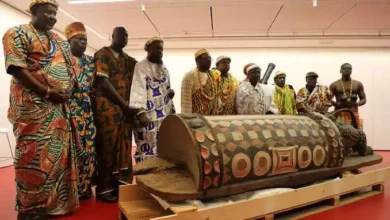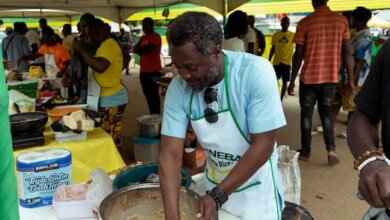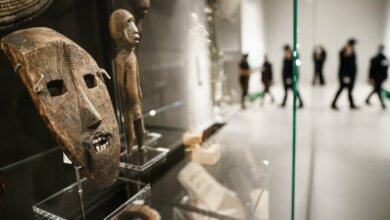The Forgotten Movement to Reclaim Africa’s Stolen Art
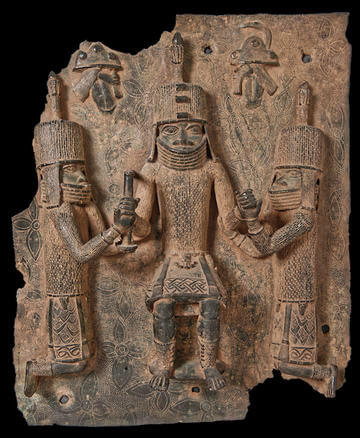
Originally published on The New Yorker by Julian Lucas
In May, 2018, the Nigerian artist Jelili Atiku shouted for help in the lobby of the Musée d’Aquitaine, in Bordeaux. “I want to go home,” he cried. “Benin. Edo . . . Take me back home!”
Dressed as a bronze warrior, with limbs bound and a British flag trailing at his heels, he mimed the desperation of an artifact trapped in the museum—which he fled stripped to the waist, revealing metallically painted skin. The performance dramatized Nigeria’s long-frustrated efforts to recover the Benin Bronzes, a collection of several thousand sculptures seized, in 1897, during the British sack of Benin City. Today, they’re dispersed among more than a hundred collections, with the greatest number kept at the British Museum.
For decades, the bronzes have served as emblems of the African struggle to reclaim art expropriated under colonial rule. More than half a million such objects—by some accounts, more than ninety per cent of all cultural artifacts known to originate in Africa—are held in Europe, where they have long seemed destined to remain.
Only twenty years ago, a group of the world’s self-designated “universal” museums declared that many stolen works had, over time, simply become “part of the heritage of the nations which house them.” In 2018, Benin’s minister of culture described meaningful restitution as about as unimaginable as “the reunification of North and South Korea.”
Now, in a very short time, a tectonic shift has occurred. In March, the Smithsonian agreed to transfer most of its thirty-nine Benin Bronzes to Nigeria, following a similar decision by Germany’s national museums. Belgium, which keeps the world’s largest single collection of African art in a gloomy palace near Brussels, has promised to review all colonial-era acquisitions with the Democratic Republic of Congo. The wave of returns has many causes, from geopolitical jockeying to the reckonings prompted by social movements like Rhodes Must Fall and Black Lives Matter.
But it was France’s President, Emmanuel Macron, who tipped the first domino. In 2017, during a state visit to Burkina Faso, he declared that “African heritage cannot solely exist in private collections and European museums.” The next year, his government issued a report that shocked many in the museum world, calling for permanent returns of looted art. France has since repatriated dozens of major works to Senegal, Madagascar, and Benin, where President Patrice Talon hailed their arrival as the return of “our soul.”
Read Also: Oxford University Publish 145 Stolen Benin Artefacts in Pitt Rivers Museum
Museums rise across Africa to welcome the prodigals, from the cities of Benin to Benin City, Nigeria, where plans have been announced for a sprawling, David Adjaye-designed Edo Museum of West African Art. Yet there are also rumblings of a backlash. Only a handful of objects have actually been restituted, despite thousands of outstanding requests. Few governments have enacted general return policies. And some of the largest institutions, like the British Museum, have actively avoided the conversation. Could the West’s museums be waiting out the clock, making tactical concessions before reverting, at the stroke of midnight, to what Ishmael Reed once described as “Centers of Art Detention”? Quiet as it’s kept, they’ve done so before.
“Nearly every conversation today about the restitution of cultural property to Africa already happened forty years ago,” Bénédicte Savoy writes, in “Africa’s Struggle for Its Art: History of a Postcolonial Defeat.” Her revelatory new book—translated, from the German, by Susanne Meyer-Abich—charts the course of an all-but-forgotten movement, which began in the nineteen-sixties, Africa’s decade of independence, and faded in the eighties, when European museums succeeded in burying its demands. In the twenty years between, battles raged in magazines and on television, at conferences and exhibitions, on the floors of West Germany’s Bundestag and Britain’s House of Lords.
The debate even reached the United Nations, where, in 1978, the Director-General of UNESCO, Ahmadou-Mahtar M’Bow, issued a moving appeal on behalf of the world’s culturally plundered peoples. “Everything which has been taken away, from monuments to handicrafts—were more than decorations,” he said. “They bore witness to a history, the history of a culture and of a nation whose spirit they perpetuated and renewed.”
Away from the bright lights of political assemblies, in the quiet offices of Europe’s ethnographic collections, museum professionals mounted a white-gloved resistance. Publicly, this involved a rhetoric of universalism, the exaggerated spectre of vacant museums, and diversionary offers of developmental assistance. Privately, it extended to sabotaging international committees, ostracizing dissenters, and denigrating African claimants as unfit to conserve their heritage.
The most essential tactic was secrecy, particularly the concealment of inventories and provenance information. This bureaucratic counter-revolution centered on West Germany, where Savoy unearths a coördinated effort to block restitution claims. Her investigation yields a riveting scholarly whodunnit that doubles as a timely warning, in her words, that “museums also lie.”
Savoy, an art historian at the Technical University of Berlin, isn’t just an expert on restitution but an architect of its twenty-first-century advance. In 2018, she co-authored France’s landmark report, with the scholar Felwine Sarr. (Last year, both were named to Time’s list of the world’s most influential people.) Beyond the return of a few notorious treasures, they proposed a “new relational ethics” between Western museums and African countries, advocating for increased provenance research, the sharing of colonial archives, and an acknowledgment that many “scientific” collecting expeditions had been just as coercive as conquests. Sarr and Savoy also insisted that restitution could be culturally generative, restoring inert artifacts to communities where they could once again serve as “forces of germination.”
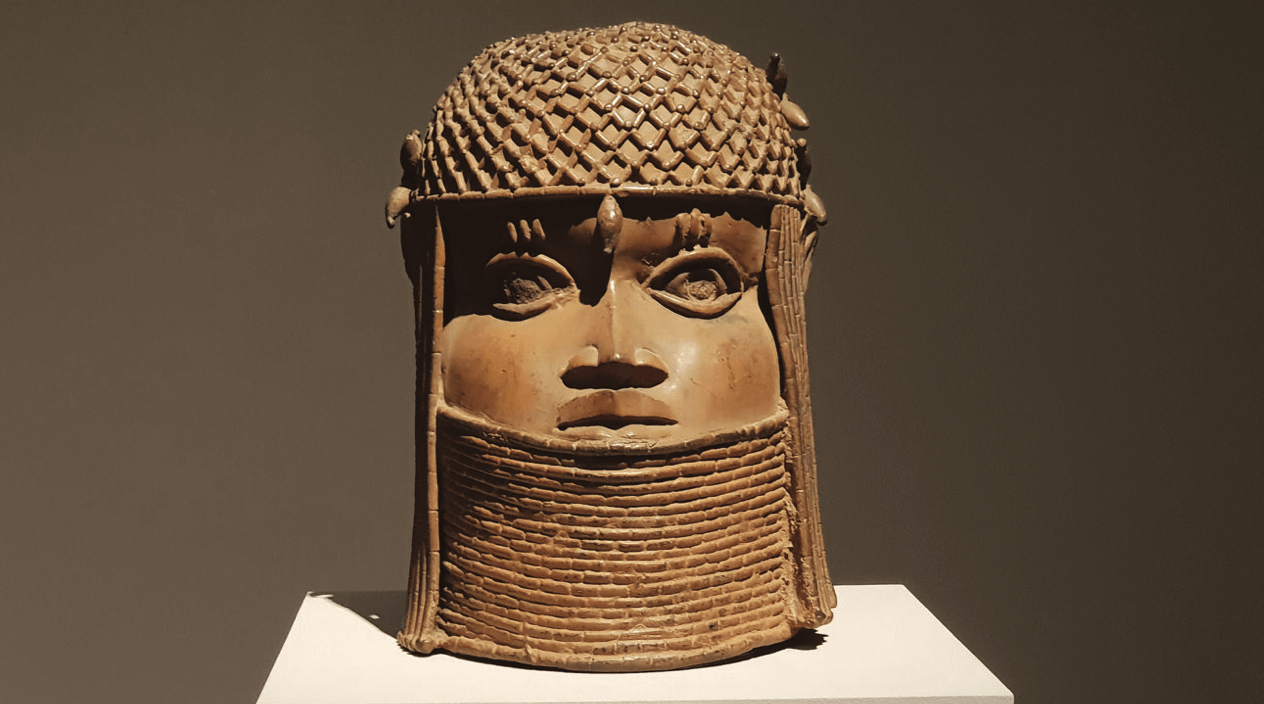
It’s an argument that African intellectuals have been making for nearly half a century. In 1965, the Beninese writer Paulin Joachim asked Western museums to “liberate the black deities, which have never been able to play their role in the frosty universe of the white world where they are held captive.” His polemic appeared in the pan-African magazine Bingo, during preparations for the 1966 World Festival of Black Arts, in Dakar—a cultural début pageant for the continent’s newly independent nations. European museums had agreed to lend art works for an accompanying exhibition, but barred any discussion of restitution. Western art experts were already positioning themselves as guardians of African culture, and Joachim mocked their “dazzling dialectics,” excoriating attempts to frame colonial plunder as an act of rescue.
Others joined his call. Savoy explores the work of Nii Kwate Owoo, a Ghanaian filmmaker whose 1971 documentary short, “You Hide Me,” follows a Black man and woman into the basement of the British Museum. While the two unwrap artifacts from storage crates, a narrator explains that such objects were once used as “propaganda material” against the allegedly uncivilized—only to be turned, after independence, into “masterpieces” that Europe could use to define “authentic” African tradition. (Representatives of the British Museum slunk out midway through a London screening.) More elegiacally, the Nigerian poet Niyi Osundare wrote verses for a Benin mask in Europe, describing it as “A god deshrined . . . Dissected by alien eyes.”
Read Also: Frédéric Bouabré: Museum of Modern Art is Finally Paying Attention to Great African Artists
These grievances burst onto the world stage in October, 1973, when Mobutu Sese Seko, the President of Zaire, speaking on the floor of the United Nations, denounced the “barbarous, systematic pillaging” of Africa’s cultural patrimony. His speech inaugurated a highly public debate on art restitution, which accelerated, the next year, when Ghana’s kingdom of Asante asked the British Museum to return regalia stolen during the sack of Kumasi, in 1874. Britain’s Parliament blocked the request, but other countries began to take the issue seriously, with Belgium giving more than a hundred art works back to Zaire starting in 1976. That year, UNESCO resolved to create a committee on the return of cultural property, with specific reference to colonial occupation. At the movement’s zenith, international press ran stories with headlines like “Will African Art Ever Go Home Again?” Many were confident that it would.
In December, 1974, Britain’s House of Lords met to discuss the Asante kingdom’s restitution request. “When it comes to returning booty from this country, we should tread warily,” Baroness Lee of Asheridge, a seventy-year-old Scottish noble, warned the assembly. “It may turn into a striptease.” Her racy analogy flipped the script of colonial victimhood: now it was Britannia, stripped of her empire, who would be forced to give up the booty. Such warnings spread throughout the seventies, as museums mobilized to defend the integrity of their collections. If you loan a Benin Bronze to Nigeria, the argument ran, they’ll probably ask to keep it—and if you let them keep it, soon they’ll ask for the whole collection. By the time it’s all over, Germany will have to send Nefertiti back to Egypt.
These strategies were pioneered in West Germany, which, despite being a minor colonial power, possessed lavishly endowed ethnological collections—much of them purchased from Britain. Its many competing institutions also kept excellent records, which Savoy picks apart with the muckraking flair of an attorney prosecuting white-collar crimes. Her scrupulous investigation reveals a conflict much more complicated than Africa versus the West. “In Europe,” she writes, “it was also a struggle between foreign and interior policy, between diplomacy and museums, between information and disinformation.”
Savoy’s account of the war against restitution begins in 1972, when Nigeria’s young director of antiquities, Ekpo Eyo, asked the West German Embassy in Lagos to facilitate a “permanent loan” of Beninese art works. The foreign office forwarded his inquiry to the Prussian Cultural Heritage Foundation (S.P.K.), then the custodian of the world’s second-largest collection of Benin Bronzes. Eyo’s request was seconded by members of the Bundestag, one of whom approvingly added that “Nigeria’s wishes are modest.” Surprisingly, European governments were often receptive to the idea of restitution, viewing it as an inexpensive way to earn political capital with African countries during the Cold War. The European public was amenable as well: Savoy sifts through public debates and letters to the editor from the time, and finds that women especially supported “a constructive debate.”
The opposition, by contrast, was led by “men, almost all of them over fifty years old, including many lawyers, a few former National Socialist party members, most of them without significant international experience.” Eyo’s request was ultimately considered by the S.P.K.’s director, Hans-Georg Wormit, an ex-Nazi who warned that if Germany began to “give presents” to “emerging nations . . . such a practice could not be restricted to individual cases.” He quickly mustered colleagues from across West Germany and quashed Eyo’s demand. But, as restitution gained visibility, silent refusal became less and less tenable. Panic struck with Mobutu’s speech and the appearance of a dissenter in the ranks: Herbert Ganslmayr, the director of the Übersee-Museum, in Bremen, who vocally championed restitution. After returning several works from his institution’s collection to Nigeria, Ganslmayr was ostracized by the German museum world.
Meanwhile, restitution advocates grew bolder. The organizers of FESTAC ’77, a Lagos sequel to the festival in Dakar, pointedly chose as their logo “Queen Idia,” a world-famous ivory pendant mask depicting the mother of a sixteenth-century Beninese king. As Savoy writes, the face “adorned the Nigerian capital’s promenades, parade grounds and stadiums,” even featuring in the design of a new one-naira note. The mask itself, though, was absent, because its guardians at the British Museum had refused to loan it.
Read Also: France Returns Artefacts Stolen from Benin Republic
Publicly, they worried that it wouldn’t survive the trip. Privately, they worried that it wouldn’t be returned. They offered Eyo, who was curating the festival’s main exhibition, a replica—which, insulted, he refused. Wole Soyinka, who was on the organizing committee, was even angrier, proposing, as he recalled, that “a task force of specialists . . . including foreign mercenaries if necessary, be set up to bring back the treasure.”
The heist fantasy was a sign of both ambition and desperation. By 1978, the European press was souring on restitution, mocking M’Bow’s measured speech at the U.N. with cartoons of carts emptying the Louvre. That year, a group of German museum directors and cultural officials gathered in Bonn, where they drafted a confidential memo that Savoy describes as “the matrix of all blockades” against restitution.
The document argued that Western countries had no legal or moral duty to repatriate art works that were now “owned by humanity as a whole.” It suggested changing the word “restitution” to “transfer,” imposing onerous conservation requirements on claimants, and refraining from the publication of catalogues that might encourage “covetousness.” Above all, the group insisted that history didn’t matter. “The way in which objects arrived in the collections of Europe and North America,” they wrote, was “of no consequence.”
Savoy devotes little time to refuting these arguments, preferring, in most cases, to expose their hypocrisy. Many opponents of restitution argued, in strikingly racist terms, that African art was safer in European museums than it would be shipped “Back to the Jungle,” as one ethnologist wrote. A museum director with similar criticisms wrote elsewhere that storage conditions were “scarcely acceptable” at his own institution, with some objects packed in spaces where the temperature couldn’t be regulated. Chika Okeke-Agulu, an art historian and restitution advocate, has compared this rhetoric to a thief demanding the construction of a secure facility before agreeing to return a stolen BMW.
Then there was the idea that Western art professionals were best suited to make sense of African cultural artifacts. One member of the Bonn working group argued that “third-world countries” had no real relationship to their culture; some museum officials even claimed that historically illiterate civilizations couldn’t interpret their own heritage. Where the authors couldn’t prove ignorance, they were prepared to create it.
Savoy demonstrates that West German museums actively misrepresented the provenance of their artifacts, claiming that nearly everything had been legitimately acquired—or even that Germany, unlike Britain, was largely innocent of colonial plunder on the continent. (This was far from the case.) Meanwhile, when it came to restitution requests, “other people’s scholarly exactitude was never quite good enough.”
Even as they practiced self-protective secrecy, Europe’s museums boasted of their unique capacity to enlighten the world about African art. Ethnographic collections had a special mission to “deepen intercultural understanding,” Wormit, the former Nazi, wrote in 1972, adding that many artifacts had been “forgotten in the countries of origin.” Yet only a small fraction of such works are ever exhibited—let alone widely appreciated—in Europe. Even today, the neglect is palpable: I have rarely been in emptier galleries than the African wings of the Louvre and the Quai Branly Museum, where, in 2015, I silently contemplated a group of royal statues seized during the conquest of Dahomey, in present-day Benin.
The strongest objection to restitution has always been that divvying up art according to its place of origin reinforces dangerous fictions of race and nation. To say that Old Kingdom mummies “belong” to modern Egypt, or antique marbles to twenty-first-century Greece, is to affirm the idea that human creativity is ethnically determined. It also reinforces the mythology of timeless “civilizations,” when our world has always been a whirligig of migration and mixture. In this view, Western museums protect everyone’s cultural heritage from provincial propagandists. “The museum is not a mirror of national identity but a reflection of the universal heritage of man,” a representative of the British Museum declared, in 1981. And besides, wasn’t Zaire’s Mobutu, who so loudly demanded restitution, a reactionary dictator?
It’s hard to take issue with this expansive ideal of human culture. Yet to see it as an argument against restitution posits a false choice between European universalism and African nationalism, when, in actuality, the claims of “universal” museums have long provided cover for nationalisms of their own. West German opponents of restitution once cited fears of losing the ethnographic arms race to their Communist rivals beyond the Berlin Wall. For years, France and Britain refused to entertain restitution demands because colonial-era collections were a cherished source of imperial nostalgia. Dan Hicks, a curator at the University of Oxford’s Pitt Rivers Museum, has even suggested that institutions like his were complicit in nationalist expansion, writing in “The Brutish Museums” that cultural desecration often served militarist colonial aims.
What if returning looted art is, in fact, the most cosmopolitan option available? The universalist argument against restitution—that we all deserve access to humanity’s common heritage—has less force when it comes to most African countries, unique in the world for possessing so few of their historic art works. It’s less a question of confining African art to Africa than of ending the West’s monopoly on its study and circulation. Given the religious and ethnic pluralism of many claimant countries, restitution might even be a boon to the promotion of intercultural understanding. In her resonant conclusion, Savoy argues that “to withhold the cultural heritage of humanity for the purposes of national self-assertion is not an option for the future.”
Africa’s first campaign for restitution died quietly. In 1978, West Germany succeeded in diverting UNESCO’s new committee from colonial plunder to contemporary smuggling—a serious issue, especially during Nigeria’s 1967–70 civil war, but also a convenient distraction from earlier crimes. Around the same time, Greece’s demand that the British Museum return the Parthenon marbles eclipsed other restitution claims. Another blow was the decline in cultural ambitions among African governments. Many of the continent’s independence-era leaders had been ex-journalists, intellectuals, or even poets, who emphasized the arts’ role in constructing what Kwame Nkrumah, Ghana’s President from 1960 to 1966, described as a new “African personality.” But in the late seventies and eighties, these dreams fell victim to political turmoil and the austere strictures of “development aid,” which often devastated the cultural sectors of recipient countries. Savoy concludes her story in 1985, when the debate largely faded from public view. “A blanket of leaden silence spread over European museums,” she writes, “and their colonial past began to sink into oblivion.”
It’s difficult to say how much further the current wave of restitutions will go. Yet its success has already disproved the old warnings about segregating art in ethnic silos. In a famous scene from “Black Panther,” the film’s villain, Killmonger, leads a heist at a London museum to retrieve a vibranium axe, which he uses to seize power in Wakanda—a perfect caricature of restitution as destructive nationalism. But outside the Marvel universe, the movement has been a force for creativity. In November, France returned the Dahomey statues to Benin, and a parade greeted their arrival. Thousands have seen the sculptures in a free exhibition at the Presidential palace in Cotonou, where they’re displayed alongside more than a hundred works by modern Beninese artists.
In the long run, advocates for restitution may look less like Killmonger and more like the Mu’tafikah, a group of multicultural art bandits, in Ishmael Reed’s novel “Mumbo Jumbo,” who liberate artifacts from the world’s Centers of Art Detention. Their goal isn’t revenge or ethnic chauvinism but something much worldlier—creating “renewed enthusiasms for the Ikons of the aesthetically victimized civilizations.”
Source: Originally published on The New Yorker by Julian Lucas
Abeeb Lekan Sodiq is a Managing Editor & Writer at theafricandream.net. He is as well a Graphics Designer and also known as Arakunrin Lekan.



